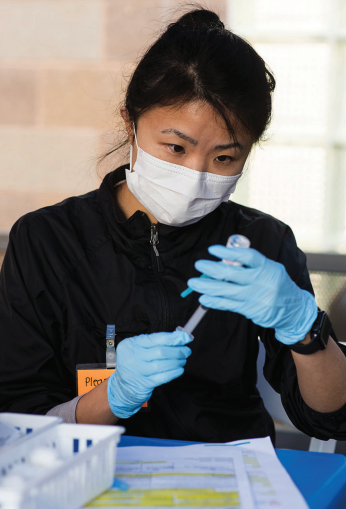Lessons Learned: Planning & Implementing a Vaccine Strategy For People Experiencing Homelessness
 The UCSF Benioff Homelessness and Housing Initiative collaborated with the California Homeless Coordinating and Financing Council and the California Health Care Foundation to create resources to help homelessness response systems with COVID-19 vaccination planning. The second in a series, these materials detail key lessons learned from the early rollout of COVID-19 vaccination events for sheltered or service-connected people experiencing homelessness.
The UCSF Benioff Homelessness and Housing Initiative collaborated with the California Homeless Coordinating and Financing Council and the California Health Care Foundation to create resources to help homelessness response systems with COVID-19 vaccination planning. The second in a series, these materials detail key lessons learned from the early rollout of COVID-19 vaccination events for sheltered or service-connected people experiencing homelessness.
On March 11, 2021, the California Department of Public Health issued guidance on vaccination eligibility that includes vaccination for individuals who live or work in congregate residential settings, including homeless shelters, as well as all people experiencing homelessness, regardless of age, as they may transition into congregate settings at short notice.
Communities across California have been working to roll out COVID-19 vaccination, including developing strategies to meet the needs of people experiencing homelessness. During February and March, some California communities held targeted events or pilots for sheltered or service-connected people eligible under the previous tiers. Here are some of the key lessons from those efforts and two spotlighted communities.
1. Collaboration continues to be critical
Vaccine has been distributed to a variety of health care organizations including large providers, pharmacies, community health centers, and public health departments. Getting vaccines to people experiencing homelessness will require a partnership between homelessness providers, Continuums of Care, and one or more health care providers. Use these links to identify possible partners including Health Care for the Homeless programs, Community Health Centers, Mobile Clinics, Tribal Health Programs, and local Public Health Departments.
2. Coordinated Preparation is Essential
Coordinating a united, ongoing approach to reach people experiencing homelessness, or even just a single targeted event, takes significant preparation. Prep work includes: Advance outreach and education Begin well in advance with outreach and education to people experiencing homelessness from trusted messengers who are representative of the community experiencing homelessness. [See Vaccine Preparation Checklist for more information.]
Plan the Logistics
Every shelter or service site will be different, but all must accommodate the steps in the process, the flow of patients, and ability to preserve distancing. An advance site visit and joint site plan may be critical.
Clarify roles and commitments
Each event requires several roles including symptom screeners, registration, clinical screening for vaccine, vaccination, and observation. Additional roles may be to help with paperwork, provide food or incentives, or be available to answer questions.
Make sure everyone is clear on their role, trained for it, and committed to staying the whole time they commit to. Have trusted and trained people on site who can answer questions. Be sure to have someone specifically designated to handle unexpected situations that arise to ensure any disruptions do not stop the patient flow.
3. Learn and Iterate
To save lives and protect people experiencing homelessness, vaccination will be a central focus of our work for the foreseeable future. Additional learnings will emerge as efforts roll out and new partnerships develop. Debrief events with all partners and refine plans accordingly. Review data to ensure the efforts are meeting their objectives and achieving equity goals. Include people with lived experience in your debriefs and future planning.